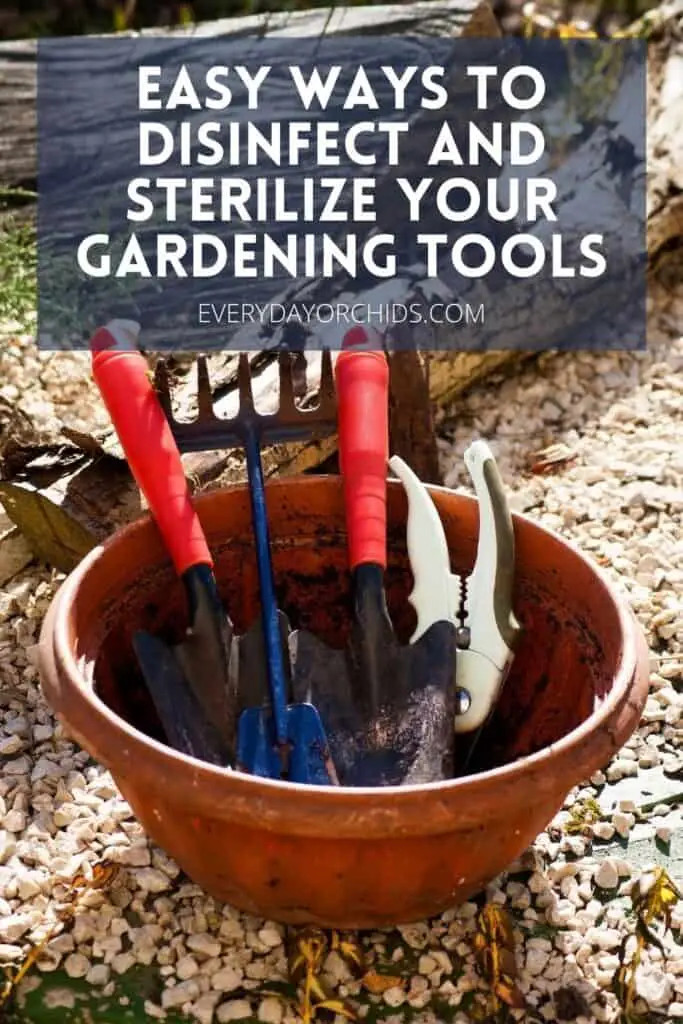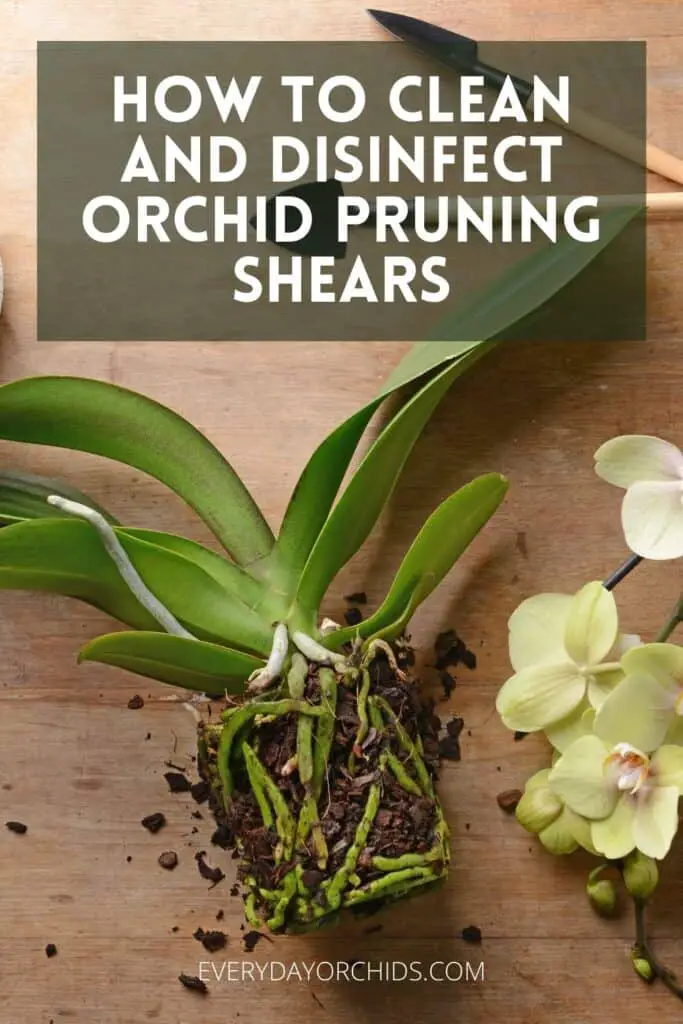I’ve talked a lot in other articles about the importance of using sterilized gardening tools to prune and cut your orchids. However, if you are new to gardening or orchid care, you may wondering how to go about doing this. How, exactly, do you disinfect and sterilize gardening tools?
It sounds complicated, right? Don’t worry, there are actually several different techniques you can use to easily sterilize your gardening tools. All of these techniques are relatively straightforward and involve inexpensive disinfecting products found in most stores. I’ll go over those in more detail below.
You can easily disinfect your gardening tools using rubbing alcohol, a 10% bleach solution, or with commercial cleaning products. Sterilizing gardening tools after each use is essential in preventing the spread of pathogens and disease. The best method is the one that is works best for you and will allow you to consistently disinfect your tools after use.
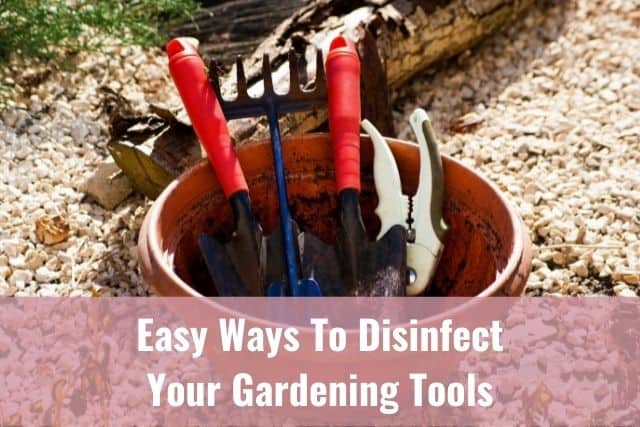
I’ll go over each of these methods below in more detail, plus answer some questions about which commercial cleaners can be used to disinfect your orchids’ pruning tools. Keep reading to learn more.
Please note that these links are affiliate links and as an Amazon Associate, I earn from qualifying purchases. Purchases made through affiliate links in this post may generate commissions at no additional cost to you. Use this link for a discounted Amazon Prime trial. Thank you for your support!
Table of Contents
Why Is It Important To Disinfect And Sterilize Gardening Tools?
Cleaning your gardening tools after each use is essential. You also want to be consistent about sterilizing your gardening tools after each time you prune your orchids or other plants. Why?
Regular disinfection and sterilization of gardening tools will help prevent the spread of pathogens between plants. It will also help prevent your tools from rusting and allow you to use them longer.
For example, some plants leak a sticky sap that will get on the shears during the pruning process. This sap can cause dirt, fungal and mold spores, bacteria and viruses to stick to the pruning shears.
Then, once the sap dries, it can be very difficult to remove. A simple soak won’t be adequate. You’ll need to do some scrubbing and more disinfecting, which takes more time and effort in the long run.
What’s even worse, those dirty gardening shears have the potential of transferring pathogens to other plants in the future. Without proper cleaning and disinfecting after each use, you may inadvertently spread disease to other plants.
What Are Some Easy Ways To Disinfect And Sterilize Gardening Tools?
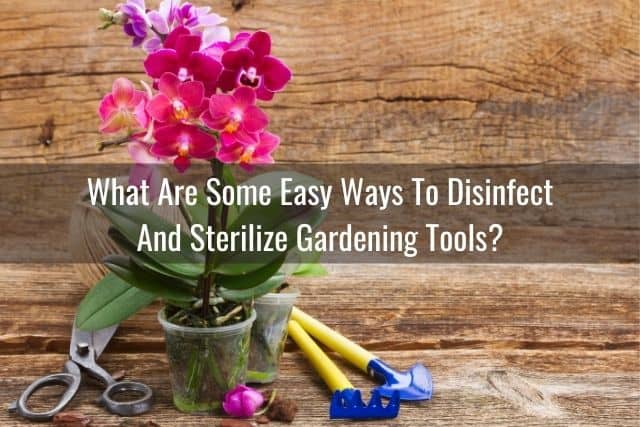
Disinfecting your gardening tools doesn’t have to be difficult or take hours. These basic methods are easy to use and take just minutes of your time, making disinfecting and cleaning your tools easy and doable.
Before using any of the methods below to disinfect your gardening tools, make sure you have removed all the visible dirt and debris from your tools first. You can do this by using the jet spray setting on the garden hose nozzle. Place the tools on the grass and rinse them down with a powerful blast of water to wash away any sap, dirt or debris stuck to the tools.
Once all the visible dirt and debris has been removed, you can choose a disinfecting solution that will work best for you. Here are some options:
Rubbing Alcohol
Rubbing alcohol, or 70% isopropyl alcohol, is readily available many stores’ first-aid section. You can use rubbing alcohol as an easy and inexpensive way to disinfect and clean your gardening tools. This is my go-to method for disinfecting my pruning tools whenever I do a quick pruning to remove dead flower spikes or diseased leaves.
To disinfect and clean your gardening tools, wet a cotton ball with rubbing alcohol and wipe down your gardening tools. You can also prepare a shallow basin of rubbing alcohol and allow your tools to soak for 5 minutes.
A third alternative is to spray rubbing alcohol over your tools. Pour rubbing alcohol into a spray bottle with a fine mist spray. Thoroughly spray down your gardening tools after each use.
This is a quick and easy way to disinfect your pruning shears between cuts and keep your tools clean. It is especially handy if you are repotting and pruning multiple orchids at once and want to avoid spreading any pathogens between plants.
10% Bleach Solution
Using a 10% bleach solution to disinfect and sterilize your gardening tools is both easy and inexpensive. All you need is a 3 or 5-gallon bucket, water and bleach. This is my favorite method for sterilizing orchid pots and repotting tools when I repot my orchids.
To make a 10% bleach solution, mix 9 parts water with 1 part bleach in the bucket. I would recommend doing this outdoors or in a well-ventilated area if possible.
Soak your gardening tools, orchid pots, and other items that need disinfecting in the 10% bleach solution. Allow them to soak for 15 to 20 minutes. Then, rinse the tools with plain water and allow to air dry.
If you are going to use this method to clean your gardening tools, I would recommend doing this a day before you plan to prune or repot your orchids. That will give your gardening shears and orchid pots enough time to dry before you need to use them.
Once you are done pruning or repotting, prepare another bucket of 10% bleach solution. You will need to disinfect your gardening tools after you are done using them.
Rinse off your pruning shears with plain water, then soak them in the 10% bleach solution for 15 minutes. Afterwards, rinse well with plain water and allow to air dry completely before you store them away.
Problems With 10% Bleach Solutions
If you are going to use 10% bleach to disinfect and sterilize your gardening tools, just be aware that most, but not all, pathogens will be killed by 10% bleach alone.
In addition, soaking your gardening tools in 10% bleach may cause corrosion. Over time with repeated use, it can lead to pitting and nicks in your gardening tools and dull the blades. To prevent corrosion and rust from occurring, rinse off your gardening tools with plain water after you finish disinfecting them in 10% bleach. Make sure they are dry before you store them away.
Dump any remaining bleach solution down the drain, rather than pouring it out on the lawn. Pouring any bleach solution onto the garden or grass can harm beneficial microorganisms and damage the plants.
Heat Or An Open Flame
You can also use heat or an open flame to disinfect or sterilize your gardening tools. If you do this, you want the temperature of the heat to be around 200 degrees Fahrenheit to kill off any pathogens. Some people put their tools in a steamer pot and use the hot steam to clean the tools. Others use a lighter and an open flame to disinfect the blades.
I personally don’t use this method because using a steamer isn’t convenient (I don’t have one) and I don’t trust myself with an open flame. For obvious reasons, make sure you don’t have any flammables nearby or use this method with any of the other disinfecting methods such as alcohol (highly-flammable) or bleach.
Commercial Disinfectants
There are a variety of commercial cleaning agents and disinfecting solutions out there, more than what I cover here. In this section, I’ll talk about whether you can use Lysol, Pine-Sol or Listerine to clean your orchid’s pruning tools, but just know that there are many more options beyond these three.
Can You Use Lysol To Disinfect Gardening Tools?
Yes, you can use Lysol to clean and disinfect gardening tools, but make sure you check the ingredients label for the active ingredients. Look for ingredients such as Alkyl and Dimethyl Benzyl Ammonium Chloride. These ingredients work to sanitize and disinfect surfaces.
Some of the main benefits to using Lysol as a disinfecting agent for gardening tools is that it is less corrosive than bleach, doesn’t need to be diluted and is relatively easy to use.
To use this to disinfect and sterilize your gardening tools, you can soak the tools in the Lysol solution (undiluted) for 2 minutes.
For even less work and clean-up, get the Lysol All-Purpose Cleaning spray and spray the solution directly onto the tool. Let the tools air dry before storing them away.
Alternatively, you can use Lysol disinfecting wipes to clean the tools. Just use one wipe per tool and throw away each wipe after use.
Can You Use Pine-Sol To Clean Gardening Tools?
Yes, you can use Pine-Sol to clean your gardening tools, but be aware that there isn’t much research out there to show how effective this method is in killing off bacterial and viral pathogens on the tools. The main benefit to using Pine-Sol is that it is less corrosive than other solutions, such as 10% bleach.
If you want to use Pine-Sol to disinfect and clean your gardening tools, you will need to prepare a one-quarter solution. Mix 1 part of Pine-Sol with 3 parts of water in a shallow basin. Soak your gardening tools in this solution for at least 5 minutes. Then rinse the tools well with plain water and dry thoroughly before storing them away.
Can You Use Listerine To Clean Gardening Tools?
No, I would not recommend using Listerine to disinfect or clean your gardening tools. There is very little research on how effective these solutions are at killing plant pathogens. What’s more, when you look at the per ounce cost comparison, Listerine is more expensive than bleach or rubbing alcohol. If you are going to use a product to disinfect your gardening tools, I say go with one that is known to work and is less costly.
Tips For Keeping Your Gardening Tools Clean And Your Orchids Healthy
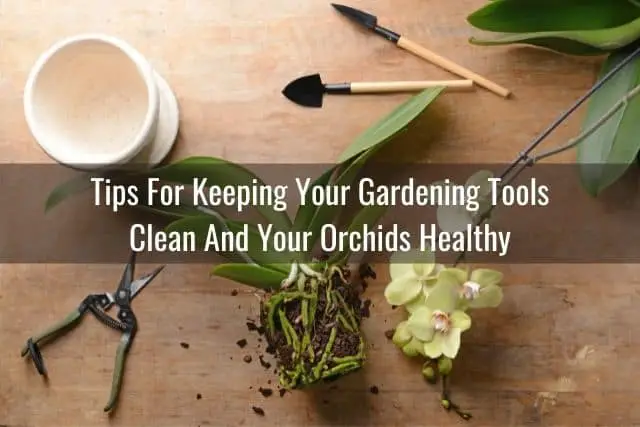
Rotate Your Tools
One of the biggest tips I have is to have more than one tool for the job and rotate your tools. If you are pruning or planning to repot your orchids, I would recommend having at least two gardening shears or pruning scissors handy.
You can use one pair on the first orchid and after you are done with that orchid, put those gardening shears to soak in the disinfecting solution of your choice. Then, while the first pair of gardening shears is being disinfected, you can use the second pair of gardening shears to prune the second orchid.
You can then switch back to the first pair of (disinfected) gardening shears for the next orchid, and so on. Just be sure to clean off the disinfecting solution from the tools before using them on your orchid to avoid damaging the plants.
Clean Before Storing Away And Before Use
Before you store away your gardening tools for the winter, clean them well. In addition, even if your tools were cleaned before storage, it’s not a bad idea to clean them again before you first use them again in the spring.
This doesn’t necessarily need to take up a lot of time, but that extra step of cleaning again before the first use helps ensure that any remaining organisms or pathogens are removed.
Thoroughly Disinfect After Caring For An Infected Plant
It goes without saying, but if you’ve used your gardening shears or tools on an infected orchid, you want to be sure you disinfect those tools thoroughly after use! Use any of the methods above to disinfect your gardening tools before using them on any other plant or orchid.
Remove Rust From Tools
Use steel wool or a wire brush to scrub the rust off your gardening tools. After removing the rust, be sure you oil the tools with a few drops of mineral oil. This will lubricate the tools and keep them opening and closing smoothly.
Final Thoughts
Hopefully you’ve learned some easy and inexpensive ways to disinfect and sterilize your gardening tools. You can use 70% isopropyl alcohol, a 10% bleach solution, or a variety of commercial cleaners. The best method is the one that you will be able to stick with and use each time you prune or repot your orchids. Taking just a few minutes to clean and disinfect your gardening tools can go a long way in preventing the spread of disease and pathogens between orchid plants.
As always, happy orchid growing!

